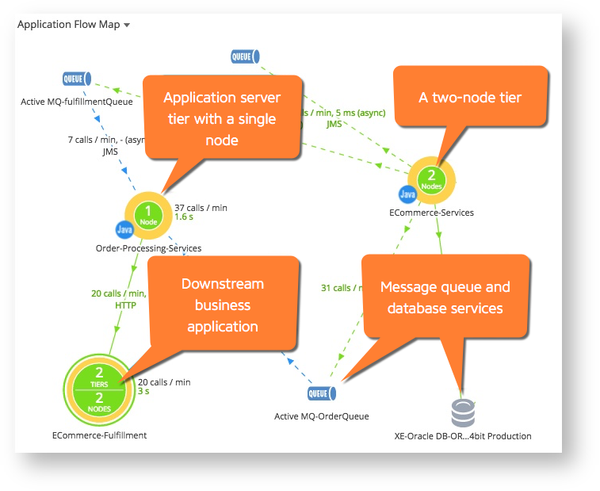- Community Hub
- Forum Q&A
- Business iQ (Analytics)
- Controller (SaaS, On Premise)
- Dashboards
- Dynamic Languages (Node.JS, Python, PHP, C/C++, Webserver Agent)
- End User Monitoring (EUM)
- Infrastructure (Server, Network, Database)
- Java (Java Agent, Installation, JVM, and Controller Installation)
- Licensing (including Trial)
- .NET (Agent, Installation)
- Smart Agent
- General Discussions
- Resources
- Groups
- Idea Exchange
Not a customer? Click the 'Start a free trial' link to begin a 30-day SaaS trial of our product and to join our community.
Existing Cisco AppDynamics customers should click the 'Sign In' button to authenticate to access the community
- Cisco AppDynamics Community
- Forums Q&A
- Java
- JMS Message Queue Entry Points on Flow Map
- Subscribe to RSS Feed
- Mark Topic as New
- Mark Topic as Read
- Float this Topic for Current User
- Bookmark
- Subscribe
- Mute
- Printer Friendly Page
JMS Message Queue Entry Points on Flow Map
- Mark as New
- Bookmark
- Subscribe
- Mute
- Subscribe to RSS Feed
- Permalink
- Report Inappropriate Content
01-28-2020 03:28 PM
In the 4.5.x documentation the diagram below depicts a flow map with message queues serving as an entry point to an application (actually the same queue acting as both an exit point for one and an entry point for another - classic pattern). We have several Java applications with JMS Message Queue Entry Points. These entry points are detected by the default BT detection rules. However, these entry points do not show up on the flow maps. Can anyone point in the right direction on how to accomplish this or is it not possible (even though it's shown that way in the documentation)?
- Mark as New
- Bookmark
- Subscribe
- Mute
- Subscribe to RSS Feed
- Permalink
- Report Inappropriate Content
01-29-2020 04:10 AM
Keith,
Queues are currently only depicted on the flowmap if they are downstream of a BT entry. The queue you see in the picture from the documentation is between the E-Commerce-Services and Order-Processing-Services tiers, and is part of a BT that originates in the E-Commerce-Services tier.
I hope that clarifies what you are seeing.
Warm regards,
Peter
- Mark as New
- Bookmark
- Subscribe
- Mute
- Subscribe to RSS Feed
- Permalink
- Report Inappropriate Content
01-29-2020 12:06 PM
Thanks Peter. I'd really like to show the end-to-end flow of asynchronous business transactions that begin in one tier and traverse one or more tiers with message queues as the integration layer. Do you happen to know if I can do that by going through the effort of defining the demarcator of the transaction's end-point?
Keith
- Mark as New
- Bookmark
- Subscribe
- Mute
- Subscribe to RSS Feed
- Permalink
- Report Inappropriate Content
01-31-2020 08:18 AM
Keith,
You should be able to do that today, if I am understanding you correctly. The only thing that you would not see visualised would be the JMS queue upstream of the 1st tier containing logic.
You can, as you suggested, have the last agent in the chain make an end to end latency calculation for the BT configuring an asynchronous transaction demarcator on the last tier that will be involved in the processing. It is most reliable to use the method instrumentation method to define the logical endpoint.
I hope that helps.
Warm regards,
Peter
Join us on Feb 26 to explore Splunk AppDynamics deployment strategies, SaaS models, agent rollout plans, and expert best practices.
Register Now
Dive into our Community Blog for the Latest Insights and Updates!
Read the blog here
- Issue with Retrieving MSMQ Entry points and Exit Calls Details in .NET consumer Application in NET (Agent, Installation)
- Couldn't get MSMQ entry point for .NET Consumer Application in NET (Agent, Installation)
- AppDynamics not detecting Error Transaction details for standalone windows service in NET (Agent, Installation)
- Common agent error in logs: Connection back off limitation in effect in General Discussions
- Couldn't get MSMQ entry point for .NET Consumer Application in NET (Agent, Installation)
| User | Count |
|---|---|
| 2 | |
| 1 | |
| 1 | |
| 1 |

Thank you! Your submission has been received!
Thank you! Your submission has been received!
Oops! Something went wrong while submitting the form
